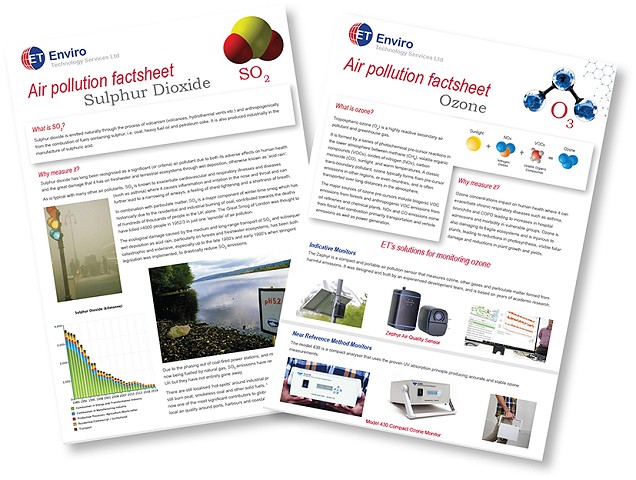Are ozone and sulphur dioxide forgotten pollutants?
That’s according to ET’s Managing Director and IAQM member, Duncan Mounsor who explains his thoughts on the question below:
Ask a local authority if they routinely measure ozone (O3) and sulphur dioxide (SO2) and most often, the answer will be no, unless they have a Defra-funded AURN station that includes analysers for these gases in their area.
But ask them again if they are measuring NOx or PM10 (or PM2.5) and I’d be very surprised if they’re not.
Both O3 and SO2 are longstanding ‘criteria’ pollutants and WHO, EU and UK national limit values exist for them due to their adverse human health effects. Wet deposition of SO2 falling as acid rain severely damages historic buildings, forests, and freshwater ecosystems, whilst increased O3 concentrations damages vegetation, plants and can lead to substantial reductions in crop yields costing $bn globally.
We’ve put together some air pollution factsheets which include O3 and SO2 and these can be viewed and downloaded here: https://www.et.co.uk/about-air-quality/air-pollution-factsheets
Let’s look at O3 and SO2 analyser numbers on the AURN. There are only 25 x SO2 analysers stretched thin across the entire UK. For O3 the numbers fare better, at 70 sites. Compare this to NO2 which is measured at over 145 AURN stations and PM10 and PM2.5 at over 154 stations (combined). Granted, we know now that PM2.5 might be the more dangerous of the pollutants mentioned above in terms of human health, but why isn’t SO2 measured at more sites and locations in the UK, and although there are far more O3 analysers on the network than there are SO2 analysers, why isn’t O3 measured by more local authorities in our towns and cities and more rural areas?
As our SO2 factsheet explains, there have been massive SO2 emission reductions over the last 30 years as we have quite rightly moved away from coal combustion as our main form of energy generation. It could be argued that the twenty-five SO2 analysers on the AURN are sufficient now for our long-term monitoring.
Can we largely forget about SO2 now then? Think again.
Shipping now represents one of the largest global anthropogenic sources of SO2 pollution, and there a lot of ships. A high percentage of your possessions will have been transported to the UK in a shipping container, on a huge container ship, belching out high concentrations of SO2.
Substantial in-roads have been made by the International Maritime Organisation (IMO) to reduce NOx and SOx emissions from ships, especially when in coastal waters, or SECAs (Sulphur Emission Control Areas) like the English Channel and North Sea. But just like with the vehicles on our roads, ship traffic crossing our oceans, sea-lanes and entering and exiting our ports and harbours is constant, incessant, and increasing.
Whilst IMO has set down rules about ships having to switch from high sulphur content heavy fuel oil to low sulphur fuel oil when in coastal waters and SECAs, SO2 pollution from ships in our coastal cities and towns could be far higher than we think, and especially in busy ports, harbours, and ferry terminals etc.
But surely SO2 is routinely measured in urban locations around our long coastline and at all our ports, harbours, and ferry terminals, right? Unfortunately not. Arguments about who should pay for the monitoring equipment, ignorance to the fact that there is a highly probable air pollution problem in the first place, and a myriad of other reasons mean that there is far less monitoring for SO2 than there perhaps should be. Is it a forgotten pollutant, or conveniently just hushed up and swept under the carpet?
I’m sure the local residents in these areas, especially those suffering from chronic respiratory illnesses, like asthma (which is on the increase in children) might like to know what the SO2 concentration is in the air that they are breathing day after day after day.
Moving on to another largely forgotten (or ignored) pollutant - Ozone.
High concentrations of O3 are extremely injurious to human health, damage sensitive ecosystems and have the potential to substantially reduce crop yields, especially at the global scale.
Increasing numbers of extreme weather events such as prolonged heatwaves can lead to dangerous build-ups of O3. In fact, high temperatures and high concentrations of O3 together present a serious risk to vulnerable groups of people, especially the elderly.
O3 is transboundary pollutant, and one reason it is not uniformly measured by local authorities is that the sources and generation of ozone may well occur outside of their geographical jurisdictions, with little if anything, for them to be able to do to control, or reduce it locally.
Feedstock pollutants that along with sunlight lead to the photochemical creation of O3 (i.e. CH4, NOx, VOCs, CO), can be emitted in another location, region, or even another country. In the UK, this pollution can actually come from continental Europe under certain weather conditions, and there’s nothing we can do about it.
Out of sight, out of mind perhaps?
In towns and cities, O3 concentrations are kept in check by nitrogen dioxide (NO2) by a series of atmospheric chemical reactions known as REDOX (oxidisation and re-oxidisation).
NO2
is supplied aplenty from tail-pipe emissions from motor vehicles, so it is typical to generally see higher concentrations of NO2 and correspondingly lower concentrations of O3 – both gases cannot be both present in any significant concentrations at the same time in the same place as the atmospheric chemistry will not permit this.
However, as we rapidly move forward with the electrification of our vehicle fleet, NO2 concentrations in urban areas will continue to fall, and O3 concentrations from spring and summertime photochemical reactions will increase. That’s chemistry in action!
This can all be neatly summed up by the UK’s Air Quality Expert Group (AQEG) in their 2021 report on ozone. “As other air pollutants in the UK continue to decline it seems likely that the importance of ozone will grow, especially as its contribution to climate provides further motivation for control measures”.
In much of the UK, our summertime temperatures now frequently exceed 30°C and often for several consecutive days. And with observed and predicted lower urban concentrations of NO2 creating the conditions to allow more O3 to exist, it unknown exactly how high future concentrations of O3 will climb, but two things are sure:
One, they are highly unlikely to go down, and two, unless we measure O3 on a more widespread basis than we currently do we won’t actually know exactly what the air quality is like at the local level. And that’s where we live, work and spend our leisure time.
So, let’s not forget SO2 and O3. They are criteria pollutants for a reason, and need to be measured, perhaps more so than currently.
Search the blog
Recent posts
Categories
Archive
- Mar 2024
- Feb 2024
- Jan 2024
- Jun 2023
- Apr 2023
- Feb 2023
- Jan 2022
- Sep 2022
- Jun 2022
- Feb 2022
- Nov 2021
- Oct 2021
- Sep 2021
- Aug 2021
- Jul 2021
- May 2021
- Apr 2021
- Mar 2021
- Feb 2021
- Jan 2020
- Sep 2020
- Mar 2020
- Jan 2020
- Apr 2019
- Feb 2019
- Jan 2019
- Dec 2018
- Nov 2018
- Oct 2018
- Sep 2018
- Jun 2018
- Feb 2018
- Nov 2017
- Oct 2017
- Jul 2017
- May 2017
- Mar 2017
- Feb 2017
- Jan 2016
- Aug 2016
- Jul 2016
- Jun 2016


























